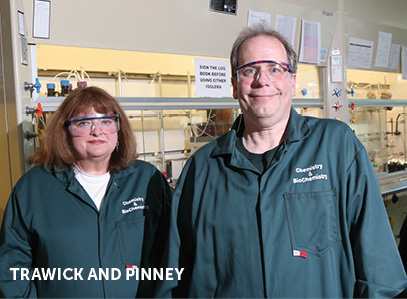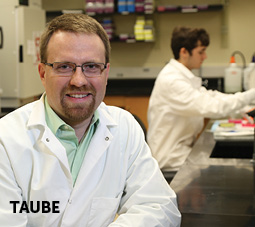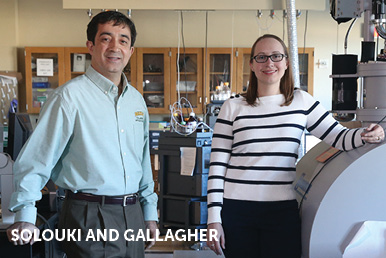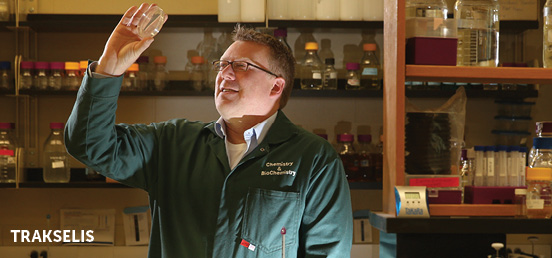8 ways Baylor researchers are battling cancer
Baylor professors and their students throughout the College of Arts and Science are engaged in high-level research focused on the fight against cancer. Each professor brings his or her own unique insight to the fight, but all seek to better understand how the disease behaves and grows in different ways, which could lead to breakthroughs in how the disease is treated.
The scope of this research was enhanced by the vision of Baylor 2012. New faculty members hired as a part of the initiative have helped grow the quantity and add to the quality of Baylor’s cancer research, and have joined with other College of Arts and Sciences faculty to bring in more than $5 million in grants and other funding over the past six years.
"The Baylor 2012 initiative was really the catalyst that transformed our department in the last decade," said Dr. Patrick Farmer, chair and professor of chemistry and biochemistry. "Since 2008, we have recruited a great set of world-class scientists, several of whom have contributed to drugs in the development pipeline. These young researchers are the future of science at Baylor."
Here are eight ways Baylor researchers are currently fighting cancer:
EYE CANCER APP // You may recall the Winter 2014 Baylor Magazine story about Dr. Bryan Shaw and his son, Noah, who developed retinoblastoma, a rare form of eye cancer that primarily occurs in infants. The Shaws noticed "white eye" in Noah's baby pictures, a possible sign of cancer. Noah lost the eye but is today an otherwise healthy child. Spurred by his family's experience, Shaw, an associate professor of chemistry and biochemistry, teamed with Dr. Greg Hamerly, associate professor of engineering and computer science, to create the CRADLE app to detect retinoblastoma by scanning pictures for "white eye." More than 41,000 people have downloaded the app, with dozens going for testing and some catching the disease early.
A STRONG TEAM // Dr. Kevin Pinney and Dr. Mary Lynn Trawick of the chemistry and biochemistry department team up to focus on two research tracks to fight cancer. They are researching ways to create small molecule anticancer drugs, which could someday stop cell division or keep tumors from receiving blood flow, killing them. Additionally, their advanced cancer research is focused on developing anti-metastatic drugs to keep the disease from spreading.
FIGHTING THE SPREAD // Cancer cells that metastasize, or spread, are the major cause of death in cancer patients. The research of Dr. Joseph Taube, BS '03, biology professor, focuses on better understanding and then fighting that spread of cancer cells. Taube, who worked with Pinney and Trawick as a Baylor student, found a gene called microRNA that plays a key role in metastasis. MicroRNA must be turned off for cancer cells to spread; Taube found that putting it back into cells blocked their spread in mice.
NATURAL PRODUCTS // Dr. Daniel Romo, The Schotts Professor of Chemistry, and Dr. John Wood, The Robert A. Welch Distinguished Professor of Chemistry and CPRIT scholar in cancer research, team up to study how molecules found in natural products could fight cancer. Romo isolated a compound from a sea sponge that could fight the spread of certain types of leukemia, and their partnership focuses on studying the cell biology of natural products in hopes of isolating those that could be used as drugs to treat cancer. Wood says that nearly all major brand-name drugs were the result of chemists studying natural products and discovering ways they can treat disease.
CLUES IN YOUR BREATH // Can your breath and saliva contain clues that an individual might be carrying early-stage cancer? That question drives the research of chemistry professor Dr. Touradj Solouki. The breath and saliva of cancer patients and healthy individuals are compared in a measuring instrument, called an ultrahigh resolution mass spectrometer, that contains hundreds of feet of tubes to segregate molecules needed for study.
UNDERSTANDING CANCER PROGRESSION // Dr. Elyssia Gallagher, assistant professor of chemistry, is conducting research on cancer progression. If a patient can't benefit from early detection, Gallagher hopes her research in how protein interactions change in patients who have the disease provides clues that appear during cancer progression. Proteins perform reactions in human cells, transport molecules in and out of the cell and allow the cell to communicate. Gallagher is studying altered proteins that can lead to cancer when a process in the cell goes wrong. Understanding these processes could lead to new ways to treat the disease.
DNA REPLICATION AND REPAIR // DNA is the building block of life, and it's constantly responding to and repairing events that could damage it. DNA actually experiences as many as a million damage events per day, but proteins in human cells fight and repair these damages. Dr. Michael Trakselis, chemistry and biochemistry associate professor, studies how DNA repairs or replicates using archea, a class of organisms mirroring what takes place in humans. Cells with damaged DNA can replicate and lead to cancerous tumors; Trakselis is focused on understanding how the body gets past DNA damage to find ways to inhibit damaged cells from replicating and leading to cancer.
MELANOMA // Does skin color make a person more prone to melanoma? Dr. Patrick Farmer is studying that question. He has focused on melanoma for more than a decade, and is examining the molecular biology of melanin, the pigments that determine hair and skin color and how those melanin react to light and environmental factors. Additionally, his research team is studying copper-based drugs and how they fight melanoma's most common mutations.
More information on these research endeavors can be found in the Spring 2016 issue of Baylor Art & Sciences magazine, or online at blogs.baylor.edu/artsandsciences.





